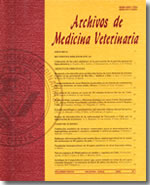Identification of contaminating bacteria when attempting to isolate Mycobacterium avium subsp. paratuberculosis (MAP) from bovine faecal and tissue samples using the BACTEC MGIT 960 system
Main Article Content
Abstract
Diagnosis of Mycobacterium avium subsp. paratuberculosis infection by liquid culture is sensitive, faster than conventional solid culture and automated. However, a disadvantage of these culture systems is the potential for high frequency of culture contamination. Contaminant bacteria were identified as a step toward better contaminant control. No mycobacteria were detected by mycobacterial Polymerase Chain Reaction-Restriction Enzyme Analysis (PRA)-hsp65. Ribosomal Intergenic Spacer Analysis (RISA) followed by sequence analysis identified Paenibacillus sp., Enterobacteriaceae and Pseudomonas aeruginosa as common contaminants. The present study aimed to identify a representative sample of contaminants encountered when culturing clinical faecal samples from Chilean cattle. Further studies involving a larger and more representative sample of animals are required to extrapolate the results to a broader population.

